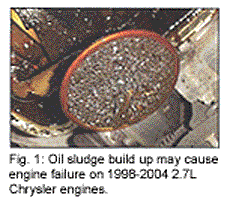Engine Builders: The AERA Technical Committee offers the following information regarding engine failure on 1998-2004 Chrysler 2.7L VIN R, U & V engines. There have been reports of premature engine failure on these engines, failures that may include tensioner failures, oil consumption and engine bearing failure.

It has been suggested that many of these failures may be the result of engine oil sludge or gelling. This condition exists when the engine’s oil is no longer able to disperse harmful contaminants, thus reducing lubrication of the needed parts. One cause of engine failure is oil sludge accumulating in the cylinder head
drain back passages preventing sufficient oil flow from the top of the engine to the oil pan. Another is a similar situation of sludge build up on the oil pump pickup screen as shown in Figure 1.
Depending upon the startup oil level in the oil pan and the amount of pooled oil while the engine is running, a depleted amount of supply oil may remain in the oil pan. The amount of oil in suspension in the cylinder heads may overwhelm both the valve stem seals and PCV system, causing oil consumption. This oil consumption may or may not produce oil smoke from the tail pipe as temperatures within the exhaust system (catalytic converter) completely burn the oil vapors.
Some engine builders report repeated engine oil flushes and oil changes may be a temporary remedy for affected engines that have not suffered major failure. Also, much shorter oil change intervals are necessary, perhaps as often as every 1,000 miles to keep the sludge from reappearing.
Engine Builders: The AERA Technical Committee offers the following information regarding camshaft gear replacement for 1985-2003 Cummins B Series 5.9L diesel engines. Throughout the use of this engine two methods have been used to retain the gear to the camshaft.
One method simply requires sufficient interference between the gear and camshaft snout diameter. The other method uses an interference fit plus a bolt and washer. The proper disassembly/reassembly must be followed for proper operation.
Disassembly:
Remove camshaft bolt and washer.
Remove gear and camshaft key.
Assembly:
Install key into camshaft.
Lubricate camshaft surface, using Lubriplate #105.
Heat gear for non-bolted 1991 camshafts to 300°F in oven.
Heat gear for bolted 1991 and 1994 camshafts to 350°F.
Install timing gear with timing marks away from the camshaft.
Verify gear is seated against camshaft shoulder.
Install camshaft bolt and washer if required and torque to 20 ft.lbs., then rotate cap screw an additional 180°.
Caution: Camshaft gear will be permanently distorted if overheated. The oven temperature should never exceed 350°F.
Note: If frets or burrs cannot be removed with Scotch-Brite 7448, or equivalent, replace the camshaft. Bolted camshafts were only used on 1991 engines equipped with an in-line pump.
For information on receiving all of AERA’s regular monthly technical bulletins and other association services and benefits, call toll free 888-326-2372 or send an e-mail to [email protected]. AERA’s Web site is www.aera.org.













